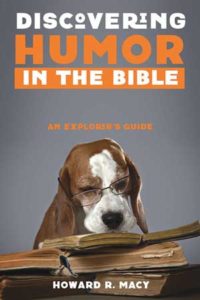Discovering Humor in the Bible: An Explorer’s Guide
Reviewed by Diane Reynolds
September 1, 2017
 By Howard R. Macy. Cascade Books, 2016. 140 pages. $19/paperback or eBook.
By Howard R. Macy. Cascade Books, 2016. 140 pages. $19/paperback or eBook.
Buy from QuakerBooks
Quakers have a tradition dating back at least to the mid-twentieth century of writing gently comedic books. Jessamyn West filled her 1945 The Friendly Persuasion with homespun humor (think of Jess hiding the forbidden piano in his attic), and Elton Trueblood‘s 1964 The Humor of Christ brought laughter into the nonfiction world. More recent writers in the humorous Quaker vein include Philip Gulley and J. Brent Bill, among others—and now, Howard Macy with Discovering Humor in the Bible.
Macy expands Trueblood’s focus on comedy from Jesus to the entire Bible, finding ribaldry in stories that might not at first glance look laugh-out-loud funny, such as Sarah conceiving Isaac in her 90s, Tamar seducing her father-in-law, or—yes—the often grim book of Job.
Macy calls his book a “field guide,” similar to a guide for identifying birds, and by that he means he will describe cues that might indicate a Bible story is funny. These include “surprise,” “exaggeration,” and “imagining them smiling” (“them” being the writers and early hearers of the stories). Macy’s explanations are clear and laced with humor; he writes, for example, that “life insurance must cost [the risk-taking biblical court jester] a bundle.” As a bonus, his book happens to provide an apt outline of what bring out the laughs in any story, not just one from the Bible.
The book represents the Quaker comedic strain well, illustrating that homespun humor continues to thrive among Friends.
Before the nineteenth century, however, the prevailing voice in Quaker writing was both intense and sincere. George Fox wasn’t joking when he warned the Turks they would burn in hell, and John Woolman didn’t find rib-tickling humor in the plight of the American slave—nor did he treat his own possible enslavement at the hands of the Indians as a light-hearted comic caper.
Jane Eyre as “plain, Quakerish governess” typified much of the nineteenth-century British view of Friends, who’d gone from being painted as dangerous radicals to the “pure lilies” of Charles Lamb’s early nineteenth-century nostalgic essay “The Quakers’ Meeting.”
Nostalgia began to take over too in American non-Friends’ depictions of Quakers as representing the pure spirit of early Americans, presumably against the immigrants increasingly entering the country from places other than England. It’s not surprising that the nostalgia leaked into Friends’ own self-depictions and that the homespun humor of the modern Quaker fiction was born.
This brings us back to Macy’s book. The bulk of it indexes comic chapter and verse in different parts of the Bible, which Macy invites us to reread with new eyes. Macy includes humor in Genesis and Judges, Esther, the Prophets, the Wisdom books, stories about David and other Hebrew Bible favorites, and then moves into humorous stories from the New Testament.
As Macy generously notes, he’s not the first to detect comedy in Bible tales we tend to read as straight, yet his book serves as a useful reminder, in an age of Bible literalism, that the Bible is a grab bag of styles and genres, of the real and the fanciful, the poetic and the prosaic. It is a work of spiritually inspired art rather than a grimly literal history of God’s presence in the world. As Macy suggests, the authors of the Bible did understand metaphor, word play, and genre. As Dava Sobel points out in Galileo’s Daughter, even seventeenth-century Roman Catholic inquisitors knew that a reference to the four corners of the earth wasn’t meant to be taken literally. With the Bible still so much in a tug of war between those who read it as deadly serious literal truth and those who reject it too passionately, it’s good to have Macy’s reminder that we can all lighten up.
At the same time, as Macy notes, humor encompasses both the homespun and the sharply satiric—and thus maybe the sharply satiric, even if unsettling rather than domesticating, can find a home in Quaker writing. Friends Journal readers may also be interested in the 2016 Quakers and Literature, a collection of essays edited by James W. Hood and volume 3 in the series Quakers and the Disciplines, published by Friends Association for Higher Education (reviewed in the November 2016 issue of Friends Journal).



Comments on Friendsjournal.org may be used in the Forum of the print magazine and may be edited for length and clarity.